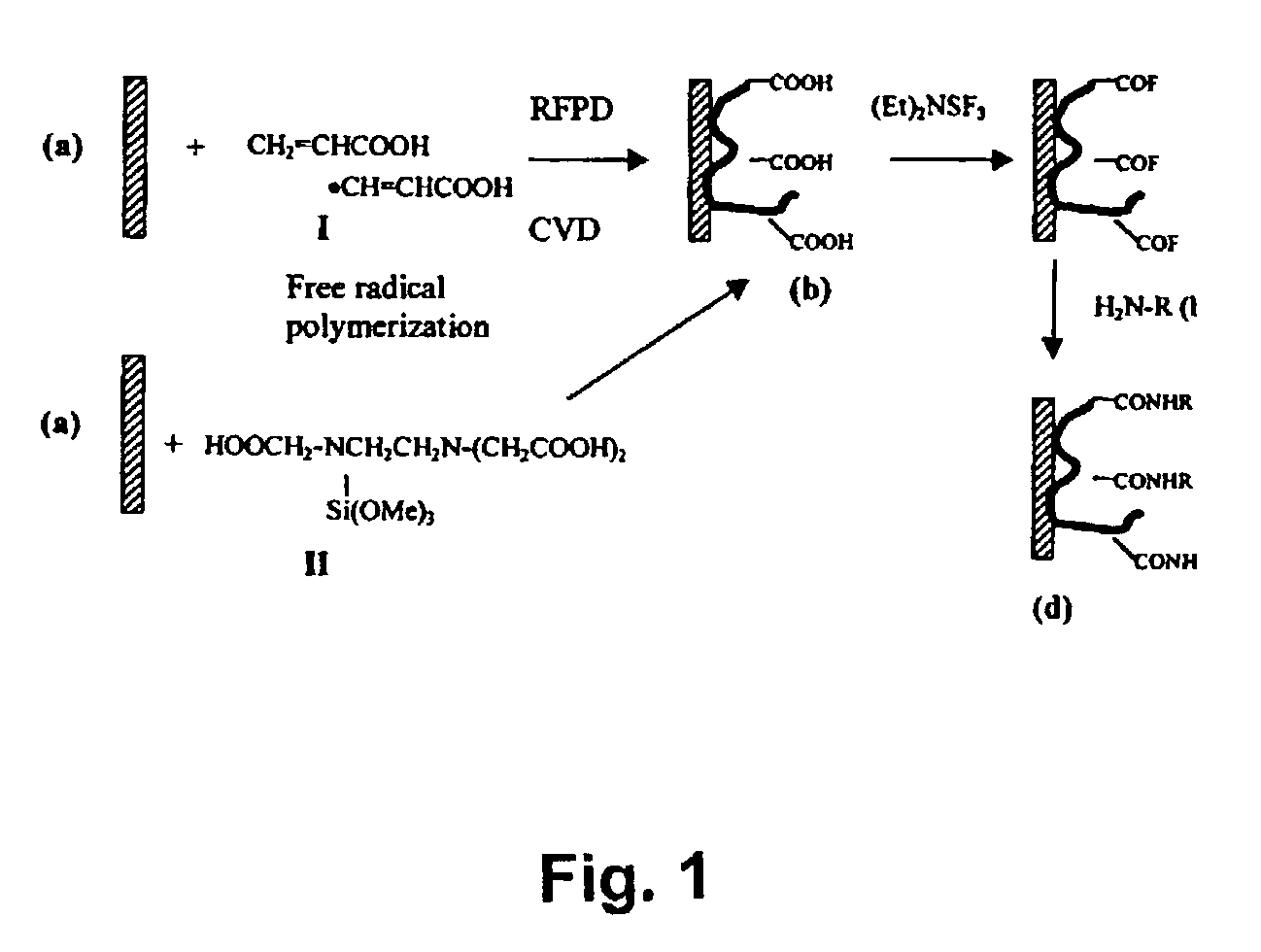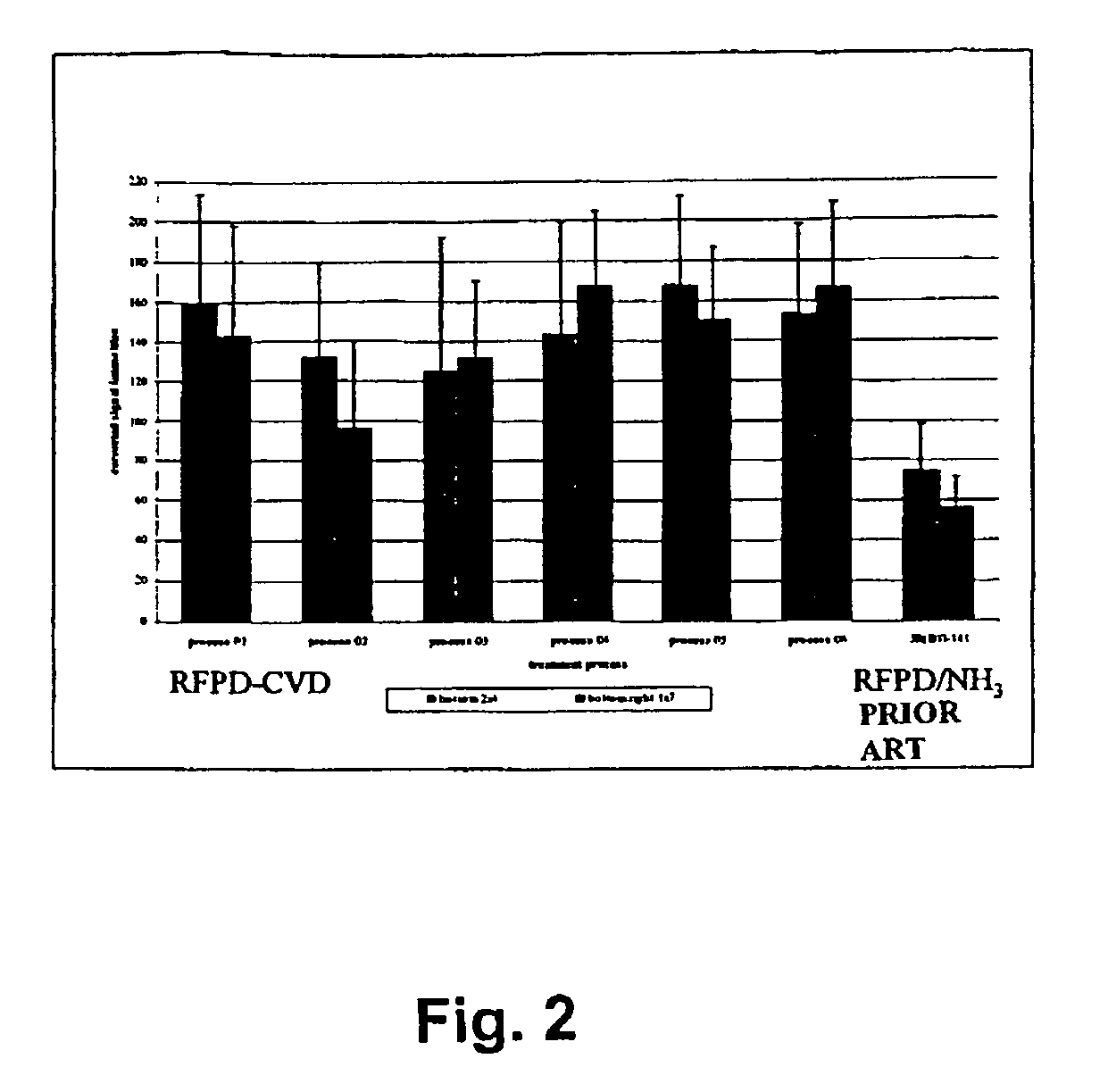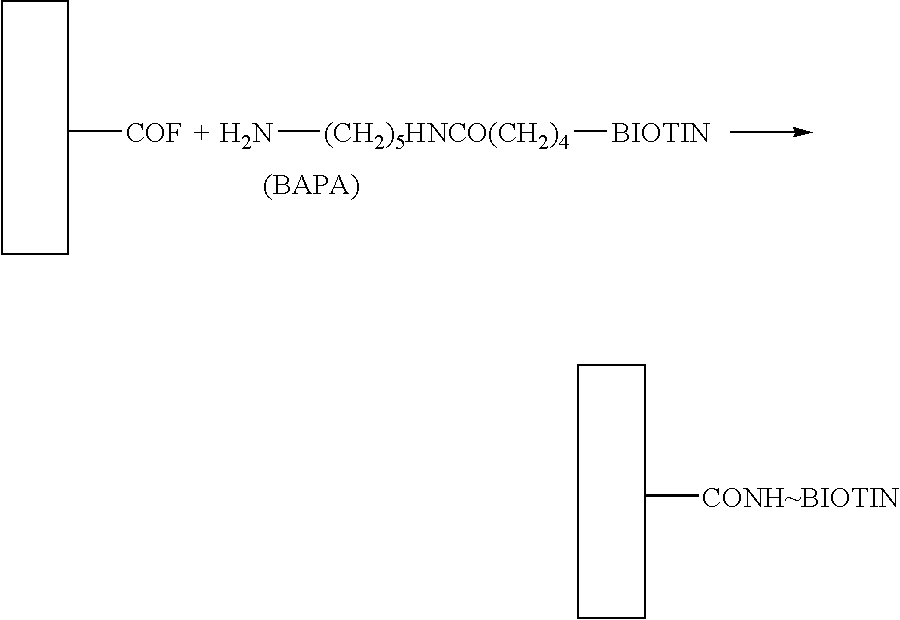Polymer-coated substrates for immobilization of biomolecules and cells
a technology of biomolecules and substrates, applied in the field of polymer-coated substrates for can solve the problems of inability to achieve precise array construction, inability to afford the precision of biomolecule and cell attachment, and insufficient stable immobilization of biomolecules and cells on the substrates, etc., to achieve reasonable shelf life, stable, physical rugged
- Summary
- Abstract
- Description
- Claims
- Application Information
AI Technical Summary
Benefits of technology
Problems solved by technology
Method used
Image
Examples
example 1
[0107]Depositing of Polymeric Coatings of Acrylic Acid or Vinyl Acetic Acid onto Polypropylene Sheet or Glass Slides by the RFPD-CVD Process:
[0108]Clean glass slides and / or polypropylene polymer sheets were placed in a plasma chamber. The materials were subjected to RFPD (radiofrequency plasma discharge) initiated oxygen plasma (˜150 to ˜180 mtorr O2; ˜450 to ˜500 watts, RF power, 3 minutes), immediately followed by the introduction of acylic acid (or vinyl acidic acid) monomer aerosol delivered to the chamber under an argon atmosphere (˜240 mtorr Ar; 500 watts, RF power, 3 minutes). The plasma polymerization process was quenched in an argon atmosphere (˜165 mtorr Ar; 0 watts, RF power, 3 minutes). The coated materials were removed from the chamber and stored in sealed polyester bags.
[0109]The deposition of polymeric coatings of acrylic acid (AA) and vinyl acetic acid (VA) was repeated at various power levels in order to determine optimal conditions for the novel process of the pres...
example 2
[0110]Preparing Substrates for Biomolecule Immobilization by the RFPD / NH3 Method of Prior Art:
[0111]Polypropylene polymer sheets were placed in an RFPD plasma chamber. The chamber was evacuated and filled with anhydrous ammonia gas (˜250 mtorr, NH3, 4 minutes). RFPD was initiated for 2 minutes at 200 watts, RF power in an ammonia atmosphere (˜300 mtorr). Power was turned-off and the substrates quenched under ammonia (˜250 mtorr, 2 minutes), followed by argon (˜265 mtorr) for 10 minutes. The surface-aminated materials were removed from the chamber and stored in sealed polyester bags.
example 3
[0112]Comparison of Biomolecule-Binding Capacity of Coated Substrates of the Present Invention and Aminated Substrates of the Prior Art:
[0113]Polypropylene slides, microplates, and glass slides were coated by RFPD-CVD processes using acylic acid monomer or vinyl acetic acid monomer. Nucleic acids and proteins were successfully immobilized to these surfaces.
[0114]Virgin polypropylene sheets (20 mm) were surface-aminated by RFPD in an ammonia gas atmosphere, derivatized with succinic anhydride to form carboxyl groups and converted to the acyl fluoride form as described above (prior art method). Alternatively, virgin polypropylene sheets were subjected to RFPD-CVD process to prepare surface coatings of carboxylated polymers, which in turn were converted to the acyl fluoride form. To access the surface activity, each sheet was printed with an amino-biotin compound (BAPA) which became covalently attached via nucleophilic attack of
the acyl fluoride:
[0115]Following incubation with strepta...
PUM
| Property | Measurement | Unit |
|---|---|---|
| RF power | aaaaa | aaaaa |
| power | aaaaa | aaaaa |
| adsorption | aaaaa | aaaaa |
Abstract
Description
Claims
Application Information
 Login to View More
Login to View More - R&D
- Intellectual Property
- Life Sciences
- Materials
- Tech Scout
- Unparalleled Data Quality
- Higher Quality Content
- 60% Fewer Hallucinations
Browse by: Latest US Patents, China's latest patents, Technical Efficacy Thesaurus, Application Domain, Technology Topic, Popular Technical Reports.
© 2025 PatSnap. All rights reserved.Legal|Privacy policy|Modern Slavery Act Transparency Statement|Sitemap|About US| Contact US: help@patsnap.com



